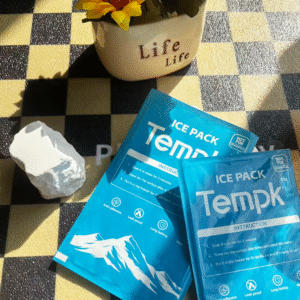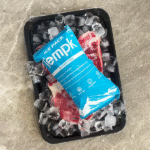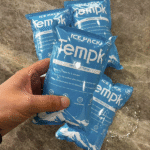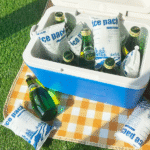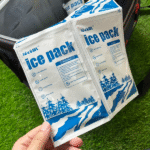Cooling Systems Dry Ice Packs: How Do They Deliver Ultra Cold Logistics?
Perkenalan: If you need to keep vaccines, seafood or desserts frozen while travelling, A cooling systems dry ice pack can maintain temperatures as low as –78.5°C (–109,3°F) hingga 72 hours without leaving messy puddles. These packs use solid carbon dioxide that sublimates directly into gas, enabling ultra cold cooling and preserving product quality even across long distances. Namun, improper handling can cause cold burns or cause an explosion if gas accumulates in a sealed container. This guide explains how cooling systems with dry ice packs work, outlines safety protocols, compares them with other refrigerants and explores 2025 innovations and market trends.
How cooling systems dry ice packs work – Learn the science behind sublimation, ultra low temperatures and why dry ice maintains consistent cooling.
Safe handling and disposal procedures – Find out how to use insulated gloves, vented containers and proper disposal to avoid accidents.
Perbandingan dengan refrigeran lainnya – See how dry ice stacks up against gel packs, water packs and phase change materials for cost, eco impact and logistics complexity.
Emerging trends for 2025 – Explore smart sensors, hybrid systems and eco friendly packaging that reduce waste by 60% and costs by 40%.
Pertanyaan yang sering diajukan – Get answers about durability, reusability, environmental impact and more.
What Are Cooling Systems Dry Ice Packs and How Do They Work?
Ilmu Sublimasi: Ultra Cold Cooling Without the Mess
Dry ice packs are solid carbon dioxide that sublimate directly from solid to gas at about –78.5 °C (–109.3 °F), creating extremely low temperatures without melting into liquid. Tidak seperti es tradisional, they avoid water leakage and maintain stable, ultra cold environments for high value goods such as biologic medicines, es krim, seafood and vaccines. When paired with insulated boxes or pallet blankets, dry ice absorbs heat while releasing carbon dioxide gas; this process maintains a consistent temperature over 48 ke 72 hours depending on insulation and ambient conditions.
The absence of liquid residue keeps packaging and products dry—a critical advantage for electronics, confectionery and pharmaceuticals that are damaged by moisture. Dry ice packs are usually sealed in breathable materials with perforations to allow gas to escape, preventing pressure build up. Because sublimation occurs evenly, you can adjust the amount of dry ice to match the required cooling duration; misalnya, high volume vaccine shipments may require larger packs or layering multiple dry ice sheets.
Beyond Freezing: Why Businesses Choose Dry Ice Cooling
When evaluating cooling systems, companies weigh cost, reliability and complexity. Dry ice packs are valued for their ability to deliver long duration, ultra cold temperatures without electricity or liquid runoff, making them ideal for remote shipments, emergency relief and cold chain logistics. They are particularly important for pharmaceuticals—biologic drugs now represent more than 50% of new approvals—which need temperatures below –20°C during transport. Frozen foods such as seafood and ice cream also rely on dry ice; the frozen food market is projected to exceed $450 miliar oleh 2027 and seafood processing consumes about 18% of global dry ice output. Karena es kering tidak meleleh, products arrive without soggy packaging or quality loss.
Dry ice cooling also enhances logistics resilience. Temperature breaks cost the pharmaceutical industry an estimated $35 billion annually and spoil about 20% of temperature sensitive products. By using dry ice packs with insulated containers and real time monitoring, companies dramatically reduce the risk of temperature excursions. Some vaccine distributors have reported improved delivery efficiency by pre conditioning their containers and adding vented insulation layers around dry ice packs.
A Closer Look at Hybrid Cooling Systems
Many modern cold chains don’t rely exclusively on dry ice. Alih-alih, they combine dry ice packs with bahan perubahan fase (PCMS), gel packs or mechanical refrigeration untuk menciptakan sistem pendingin hybrid. PCMs absorb or release heat at specific temperatures, while gel packs maintain 2–8 °C ranges ideal for chilled goods. Hybrid systems use dry ice for the initial freeze and PCMs for temperature maintenance; this reduces dry ice consumption and provides longer cooling durations. Misalnya, adding PCM panels above dry ice packs helps maintain stable temperatures during transit stops, reducing sublimation losses to 3–8% per day instead of 10%.
Hybrid systems also enable multi temperature loads. A container may have a frozen compartment cooled by dry ice for ice cream and a chilled section cooled by gel packs for salads. This versatility reduces packaging waste and improves shipment efficiency, particularly for last mile delivery services that handle mixed products. Hybrid solutions are trending because they balance cost, sustainability and performance—a theme explored later in this article.
Key Cooling Technologies Compared
| Teknologi Pendinginan | Kisaran suhu | Biaya & Eco Impact | Logistics Complexity | Practical Meaning |
| Paket es kering | –78.5°C to –20°C; suhu yang sangat rendah | High cost; higher environmental impact due to CO₂ capture requirements | Complex; requires vented packaging and safety procedures | Ideal for frozen foods, biologics and special effects when you need ultra cold and residue free cooling |
| Paket gel | 0° C hingga 8 ° C.; maintains chilled temperatures | Biaya sedang; reusable and less carbon intensive | Sedang; easy handling but can leak water | Suitable for fresh produce, dairy and short distance deliveries |
| Water packs | Around 0°C; freezer bricks or ice bags | Biaya rendah; minimal ecological impact | Sederhana; widely available and reusable | Good for picnics, beverages and short events; not ideal for long distance shipping |
| Phase change materials (PCMS) | Dapat disesuaikan (MISALNYA., –20°C, 4° C., 15° C.) | Biaya yang lebih tinggi; can be eco friendly | Moderate complexity; must be charged/frozen in advance | Offers stable, long lasting temperature control and reduces reliance on dry ice |
| Mechanical refrigeration | Bisa disesuaikan; can reach ultra low temperatures | High capital cost but zero consumable waste | Complex; requires power, maintenance and compliance | Used in reefer trucks, cold storage rooms and containerized freezers |
Practical Tips for Choosing Cooling Systems Dry Ice Packs
Kontainer yang sudah dikondisikan sebelumnya: Chill your insulated box or cooler to the target temperature before adding products. Pre chilling reduces initial heat load and slows sublimation.
Lapisan strategis: Place dry ice packs on top of goods because cold air sinks, and fill empty spaces with foam or bubble wrap to minimise air pockets.
Combine refrigerants: Untuk muatan campuran, use dry ice for frozen items and gel or PCM packs for chilled sections. This hybrid setup offers multi temperature control.
Pilih ukuran yang tepat: Estimate 5–10 pounds of dry ice per 24 hours for frozen shipments; adjust according to load weight and ambient temperature. For smaller parties or short trips, 2–3 pounds may suffice.
Gunakan kemasan ventilasi: Always select insulated containers with venting to allow CO₂ gas to escape. This prevents pressure build up and protects products.
Contoh Dunia Nyata: A vaccine distributor transporting shipments across remote regions used insulated containers with vented lids and layered dry ice packs above the payload. By pre cooling the containers and combining dry ice with PCM panels, they achieved 48 hour temperature stability and reduced dry ice consumption by 30%. This approach also simplified handling because staff only replaced PCM panels during refueling stops, avoiding the need to open containers and risk contamination.
How to Handle and Dispose of Cooling Systems Dry Ice Packs Safely?
Essential Safety Precautions: Protecting Yourself and Others
Working with dry ice requires respect for its extreme cold and gaseous state. Direct contact can cause severe cold burns, and enclosed spaces may accumulate carbon dioxide gas that displaces oxygen. To use cooling systems dry ice packs safely:
Kenakan perlengkapan pelindung: Use insulated gloves and eye protection when handling dry ice. Avoid touching it with bare skin, as even brief contact can freeze tissue.
Bekerja di area berventilasi: Always handle dry ice in a well ventilated room or outdoors. If indoors, open windows and use fans to disperse CO₂ gas.
Gunakan wadah ventilasi: Store and transport dry ice in insulated, vented containers with loose lids or small holes; never seal dry ice in airtight coolers or glass jars because the gas expansion can cause explosions.
Avoid ingestion: Never place dry ice directly into drinks or food intended for consumption. Swallowing dry ice can cause internal burns and asphyxiation.
Supervise children and pets: Keep dry ice away from curious hands. Use caution when using dry ice for fog effects at parties; supervise the area to prevent accidental contact..
Safe Storage and Transportation Guidelines
Transporting dry ice in vehicles or aircraft requires planning. Only a limited amount (biasanya 2.5 kg per package on air shipments) is allowed, and packages must be labelled as “Dry Ice” to comply with regulations. For road transport, avoid placing dry ice in the trunk of a car; alih-alih, keep windows open to allow gas to escape.
When storing dry ice packs:
Insulation and venting: Use double walled boxes or foam coolers with vented lids. Never tape or seal the container entirely, as CO₂ build up could rupture the packaging.
Label and separate: Mark containers clearly with “Dry Ice – CO₂ gas” warnings, and separate dry ice from flammable materials or products that may be damaged by extreme cold.
Plan deliveries: Because dry ice sublimates at 3–8% per day even with good insulation, coordinate shipping schedules to minimise transit time and have contingency plans for delays. Real time temperature monitoring devices can send alerts if temperatures deviate from safe ranges.
Pembuangan: Let It Sublimate
The safest way to dispose of dry ice is to allow it to sublimate in a well ventilated area. Place remaining dry ice in an open container outdoors or in a vented room and keep away from children and pets. Do not pour dry ice down drains or throw it in trash chutes—if trapped in a confined space, sublimating CO₂ can cause pipes or trash bins to explode.
Skenario Praktis: After a successful delivery, a food service manager disposed of unused dry ice by leaving it in a designated open container in the loading bay. The dry ice slowly sublimated within a day. The manager ensured signage warned staff about the hazard and kept the area ventilated to avoid CO₂ accumulation. This simple practice prevented a waste chute explosion that might have occurred if the dry ice had been discarded with general waste.
Cooling Systems Dry Ice Packs vs Gel Packs and Other Alternatives
Why Comparison Matters
Different cooling technologies serve different purposes. Understanding their strengths and limitations helps you choose the right solution for each shipment or event. Dry ice packs deliver ultra low temperatures but come with higher costs and more complex handling, while gel or water packs provide moderate cooling with fewer safety precautions. Phase change materials offer custom temperature control and longer duration; mechanical refrigeration eliminates consumable use but requires power and maintenance.
Comparative Analysis Table
| Atribut | Paket es kering | Paket gel | Water Packs | Phase Change Materials | Pendinginan Mekanis |
| Daya pendingin | Extremely low temperatures; suitable for frozen goods | Chilled temperatures (0–8 ° C.) | Short term cooling around 0 ° C. | Custom ranges; stable for long periods | Variabel; can reach any set point |
| Biaya | High due to CO₂ capture and production | Sedang; dapat digunakan kembali | Rendah | Biaya awal yang lebih tinggi | High capital but no consumables |
| Dampak Lingkungan | Higher carbon footprint; sustainable production using captured CO₂ reduces waste | Lebih rendah; reusable materials reduce waste | Minimal; dapat digunakan kembali | Bervariasi; some PCMs are biodegradable | Depends on power source; solar or renewable energy reduces impact |
| Kemudahan penggunaan | Membutuhkan ventilasi, protective gear and careful disposal | Easy; minimal safety precautions | Sederhana; Tersedia secara luas | Requires freezing or charging; moderate complexity | Requires power supply, maintenance and trained operators |
| Terbaik untuk | Makanan beku, biologic medicines, long distance shipments | Produk segar, susu, vaksin (2–8 ° C.), short deliveries | Minuman, makan siang, piknik | Biofarma, Makanan Khusus, mixed temperature loads | Pengiriman besar, gudang, truk berpendingin |
Membawa pergi: Use dry ice packs when you need extreme cold for extended periods or to avoid melting messes. For general chilled shipping or household needs, gel packs or water packs are more economical and user friendly. Phase change materials and mechanical refrigeration are best for highly sensitive products or permanent installations.
2025 Trends and Innovations in Cooling Systems Dry Ice Packs
Ikhtisar Tren: Resilient and Sustainable Cold Chains
The cold chain industry is rapidly evolving due to supply constraints, sustainability demands and technological advances. Dry ice consumption is growing at about 5% setiap tahun, while global CO₂ supply grows only 0.5%, leading to supply shortages and price surges up to 300%. To adapt, companies are adopting hybrid cooling systems, smart monitoring and eco friendly materials. The global dry ice market is valued at around $1.54 miliar masuk 2024 and projected to reach $2.73 miliar oleh 2032 (7.4% CAGR).
Pada saat yang sama, cold chain logistics revenue reached USD 364 miliar masuk 2024, and the dry ice production equipment market is expected to grow to $340 million by 2032. Emerging economies are investing roughly $3 billion annually in cold chain infrastructure, while biologic drug manufacturing is growing 12% per tahun. These figures highlight the importance of resilient cooling technologies.
Smart Sensors and Real Time Monitoring
IoT enabled sensors now monitor temperature, kelembaban dan lokasi secara real time. They alert shippers whenever conditions drift outside safe ranges. Some systems also log travel time and environmental data on blockchain networks, creating tamper proof records that ensure regulatory compliance and product integrity.
Solar Powered Cold Storage and Renewable Energy
Solar powered cold storage units provide reliable refrigeration in off grid or rural areas. These units generate electricity at costs ranging from 3.2–15.5 cents per kWh, often lower than the average grid price of 13.10 cents. Solar power reduces operational expenses and carbon emissions, making it a compelling option for last mile delivery hubs and farms.
AI and Route Optimisation
Artificial intelligence analyses traffic, weather and logistic variables to optimise delivery routes for temperature sensitive shipments. AI helps reduce transit time, avoid extreme weather and improve fuel efficiency. Misalnya, adjusting routes in real time can prevent delays that cause dry ice to sublimate faster or cause temperature excursions.
Portable Cryogenic Freezers and Micro Pellet Equipment
Portable cryogenic freezers maintain temperatures from –80 °C to –150 °C, protecting cell and gene therapies during transport. These devices often include GPS and temperature tracking to ensure compliance. Sementara itu, micro pellet dry ice production equipment provides 99% pellet size consistency and opens new applications such as precision cleaning; this micro pellet niche market is growing 18% setiap tahun.
Sustainable Materials and Eco Friendly Packaging
To mitigate environmental impact, manufacturers are switching to captured CO₂ from biogas plants and recyclable insulation. Such innovations can reduce packaging waste by 60% and decrease costs by 40%. Sustainable packaging includes biodegradable wraps, reusable cold packs and drain friendly gel packs. Reusable cold bins are gaining traction; a survey found that 38% of biopharma companies used reusable rental containers in 2020, and the trend continues to rise.
Summary of 2025 Inovasi
| Inovasi | Key Feature | Practical Meaning |
| Sensor pintar & blockchain | Suhu waktu nyata, humidity and travel logs stored on secure networks | Enables proactive responses to temperature deviations and ensures regulatory compliance |
| Pendinginan hibrida & micro pellets | Combining dry ice with PCMs; micro pellet equipment provides consistent pellet size | Mengurangi konsumsi es kering, delivers targeted cooling and supports precision cleaning |
| Solar powered storage | Solar units deliver power at 3.2–15.5 cents/kWh | Offers off grid refrigeration and lowers energy costs |
| AI route optimisation | Algorithms adjust routes based on traffic and weather | Shortens transit time and reduces product spoilage |
| Portable cryogenic freezers | Maintain –80 °C to –150 °C; feature GPS and live monitoring | Protects advanced therapies and research samples during transport |
| Bahan ramah lingkungan | Captured CO₂ and recyclable insulation reduce waste and cost | Supports sustainability goals and lowers packaging expenses |
Pertanyaan yang sering diajukan (FAQ)
Q1: How long do cooling systems dry ice packs last?
Dry ice packs generally last 48–72 jam in properly insulated containers. Duration depends on ambient temperature, insulation quality and the amount of dry ice used. Untuk perjalanan panjang, use additional packs or combine with PCMs to extend cooling periods.
Q2: Can I reuse cooling systems dry ice packs?
Dry ice itself sublimates into gas and cannot be reused. Namun, the insulated sleeves or containers can be reused if they remain intact. If you need reusable cooling solutions, consider PCM packs or gel packs, which can be refrozen and reused multiple times.
Q3: Are cooling systems dry ice packs safe for food and drink?
Ya, dry ice can safely cool food as long as it remains outside the packaging and does not touch consumables directly. Never place dry ice cubes directly into beverages or foods because ingestion can cause internal injuries.
Q4: How do I dispose of unused dry ice packs?
Place leftover dry ice in an open, well ventilated area and allow it to sublimate. Do not throw it in bins or down drains, as the gas expansion could cause explosions.
Q5: What is the environmental impact of dry ice packs?
Dry ice production often uses by product CO₂ from industrial processes; Karena itu, it doesn’t introduce new carbon dioxide into the atmosphere. Namun, its environmental footprint is higher than gel or water packs due to energy used in production. Eco friendly practices—such as capturing CO₂ from biogas and using recyclable insulation—can reduce waste by 60% and cut costs by 40%.
Q6: Berapa banyak es kering yang saya butuhkan untuk pengiriman?
Rough guidelines suggest 5–10 pounds of dry ice per 24 jam for frozen shipments and 2–3 pounds for smaller loads or short duration events. Factors such as ambient temperature, insulation quality and package size influence the exact amount.
Ringkasan & Rekomendasi
Kunci takeaways: Cooling systems dry ice packs deliver ultra cold temperatures without melting, making them indispensable for frozen foods, biologics and remote shipments. They offer stable cooling and protect product quality, but require protective gear, ventilation and proper disposal. Hybrid systems that combine dry ice with PCMs or gel packs balance performance and sustainability, while smart sensors, solar energy and AI route optimisation are reshaping cold chains for 2025. Eco friendly materials and reusable containers reduce waste and costs.
Rencana aksi:
Assess your cooling needs: Identify temperature requirements, duration and product sensitivity. For ultra cold applications like vaccines or ice cream shipments, choose dry ice packs; untuk barang dingin, opt for gel or PCM packs.
Plan packaging carefully: Kontainer yang sudah dikondisikan sebelumnya, use vented insulation, and layer dry ice above the payload. Combine refrigerants for hybrid solutions to maximise performance.
Invest in monitoring: Deploy IoT sensors or data loggers to track temperature and location in real time. Use blockchain based records when regulatory compliance is critical.
Embrace innovation: Explore solar powered storage units, AI route optimisation and portable cryogenic freezers to improve efficiency and sustainability.
Choose sustainable materials: Partner with suppliers that use captured CO₂ and recyclable insulation. Reusable containers and drain friendly gel packs reduce environmental impact and lower costs.
Dengan mengikuti rekomendasi ini, you’ll implement a resilient, eco friendly cooling strategy that keeps products safe, reduces waste and supports the evolving cold chain landscape.
Tentang tempk
Company Background: Tempk specialises in innovative cold chain packaging solutions, offering a full line of dry ice packs, Paket gel, phase change materials and insulated containers. Our research and development focus on creating eco friendly, reusable products that meet strict pharmaceutical, food and logistics requirements. Kita 2025 product portfolio includes smart dry ice packs equipped with IoT sensors, hybrid cooling kits that combine dry ice with PCMs, and recyclable insulation made from sustainable materials. We work closely with clients across healthcare, biotech and food industries to deliver tailored cooling solutions that optimise quality, compliance and environmental performance.
Panggilan untuk bertindak: Ready to upgrade your cold chain operations? Contact Tempk for personalised recommendations on cooling systems dry ice packs, hybrid solutions and sustainable packaging. Our experts can help you select the right products, design efficient logistics and integrate real time monitoring tools.






